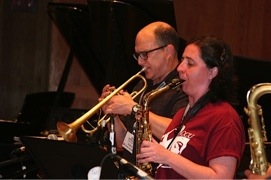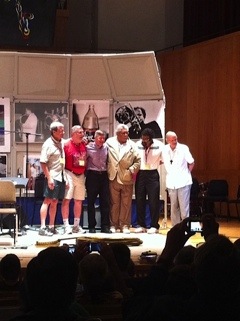Jamey Aebersold Summer Jazz Workshop Wrap-up. Wednesday, September 07, 2011
My experience at the Jamey Aebersold Summer Jazz Workshop was incredible! Beginning every morning at 8:30am with jazz theory and ending with a three hour faculty concert, every day was packed with great music and useful information.
The week began on Sunday, July 3 with a theory placement test and audition for everyone attending the workshop. The 365 attendees ranged in age from 8 to 80 and came from 27 countries. Backgrounds were as varied as novice improvisers to professional musicians and jazz educators. Based on my audition, I was thankfully placed in the advanced theory class and top combo.
David Baker from Indiana University was my theory instructor. Professor Baker is arguably the world’s preeminent jazz educator and has performed with all of the jazz giants of our time. The author of dozens of jazz publications, David Baker primarily worked with us using volume one of his publication, HOW TO PLAY BEBOP. I wanted to absorb every lecture he presented so my notes were sketchy but I recorded everything on my hard disc recorder. His classes were streams of consciousness full of first-hand anecdotes involving many of the iconic jazz figures of the 20th century.
My combo was coached by the master jazz educator, Jerry Coker. Mr. Coker has written dozens of jazz improvisation method books including the original, timeless classic, PATTERNS FOR JAZZ, published in 1970. The combo rehearsed twice each day for a daily total of three hours. These rehearsals were probably the most meaningful aspect of the entire workshop for me. Professor Coker had organized the combo’s repertoire into style periods beginning with bebop and ending with contemporary jazz. Every rehearsal was an in-depth application of jazz theory to jazz improvisation. Each musician in the ensemble would play several choruses and then pass on to the next musician for subsequent solos. After the combo was finished, Professor Coker would comment on the positive and negative aspects of each solo highlighting scales and patterns that would probably work better than what the musician had originally played. As an exercise, we would also sometimes trade solos over odd numbers of measures that didn’t correspond to the form of the tune we were rehearsing.
Instrument specific master classes were also a feature of the daily schedule. The age range and experience level of the group was across the board from young beginners to college educators like myself. Ideas and experiences were shared in a surprisingly ego-less and nonjudgemental atmosphere. It was great also to catch up with some colleagues I hadn’t spoken with in some time.
The entire week wrapped up on Friday with shortened classes in the morning and then performances by all 50 combos in the afternoon. The logistics of programming fifty ensembles on two separate stages was an amazing feat but everyone had performed by four o’clock in the afternoon and most were on their way home. The staff had just a brief rest before three hundred more participants showed up for the second week of the workshop.
The whole experience was truly spectacular and provided much food for thought and hours of material for the practice room. Being my first time at the workshop, I see the value of repeated sessions and hope to attend more in the future. The young sax player in my combo had just received her masters degree in jazz education from the University of North Carolina and was attending her seventeenth year at the workshop. I felt extremely fortunate to have had the opportunity to work with some of the giants of jazz education and hopefully will bring some of those insights and experiences back to my friends and customers at Stanton’s Sheet Music.
The Jazz Guy


